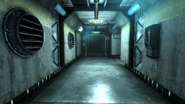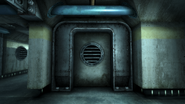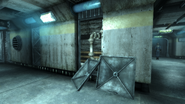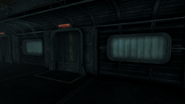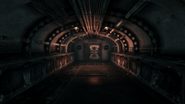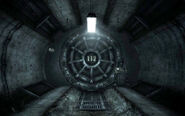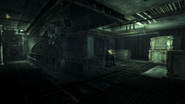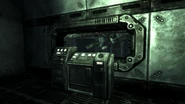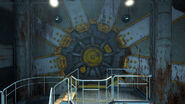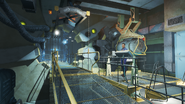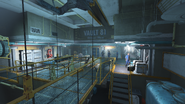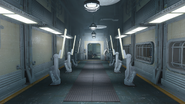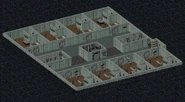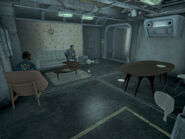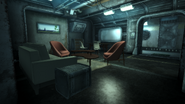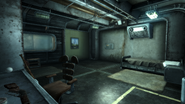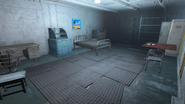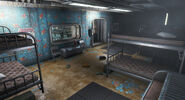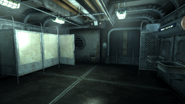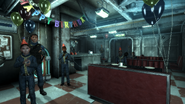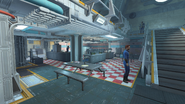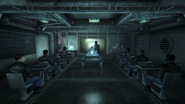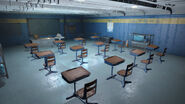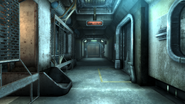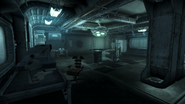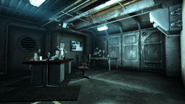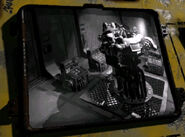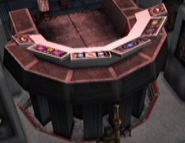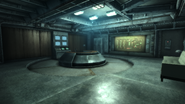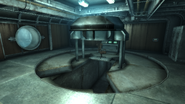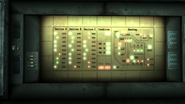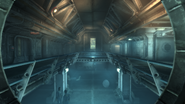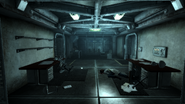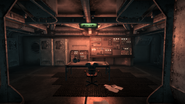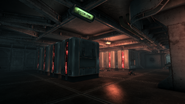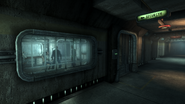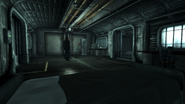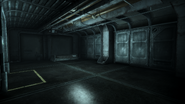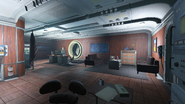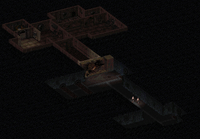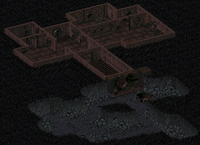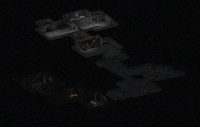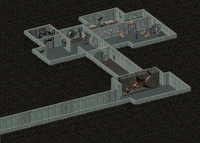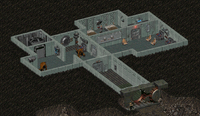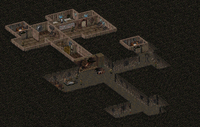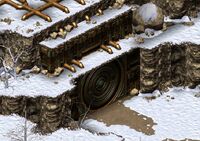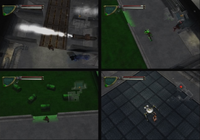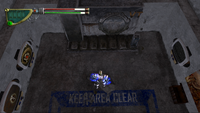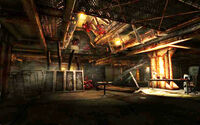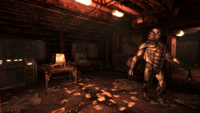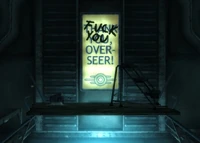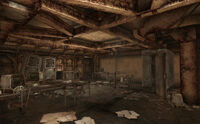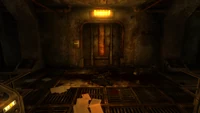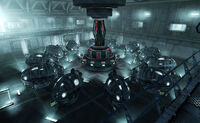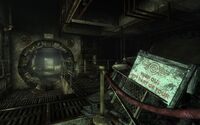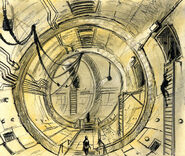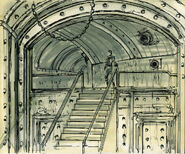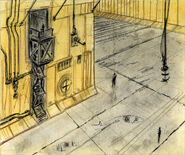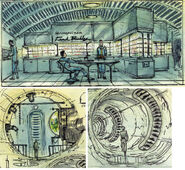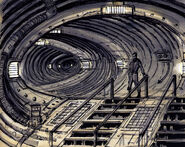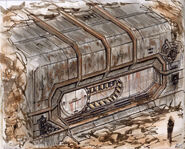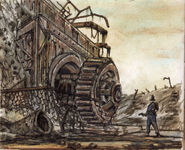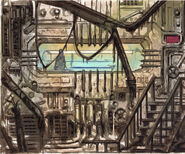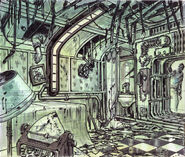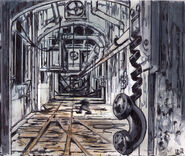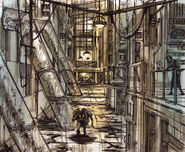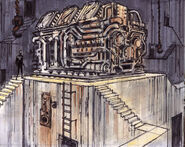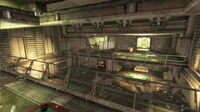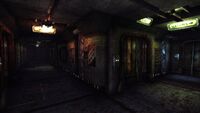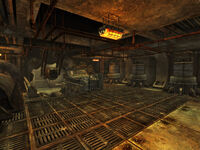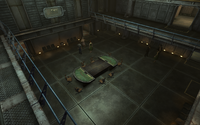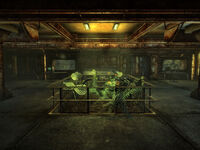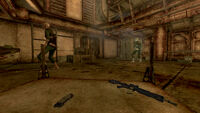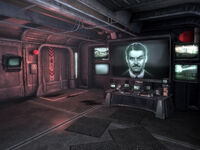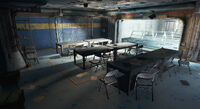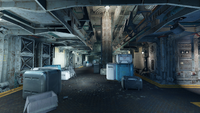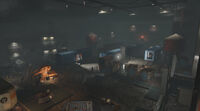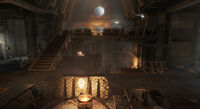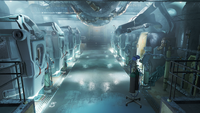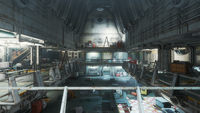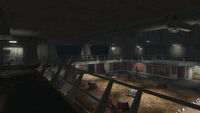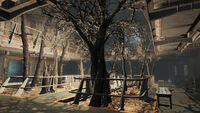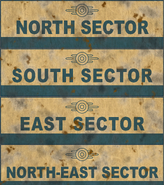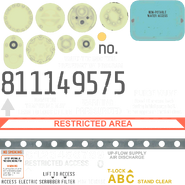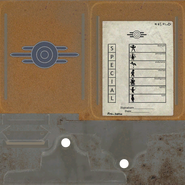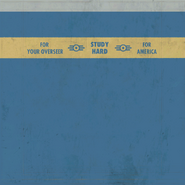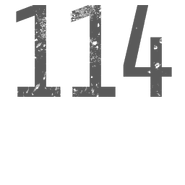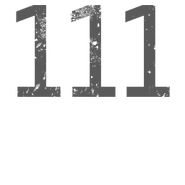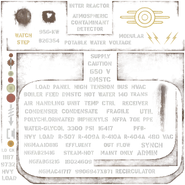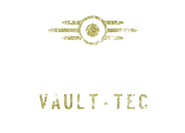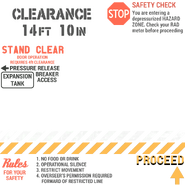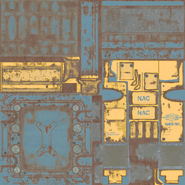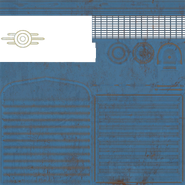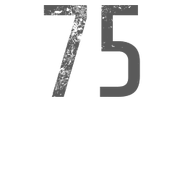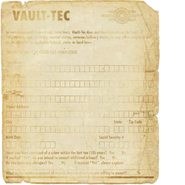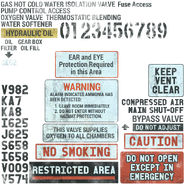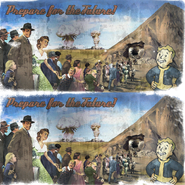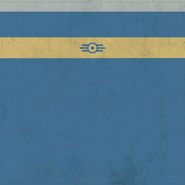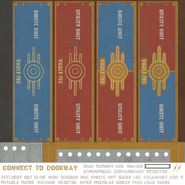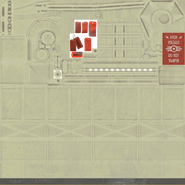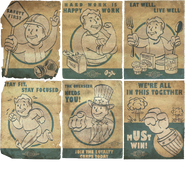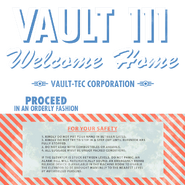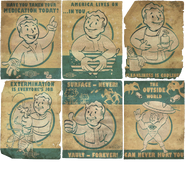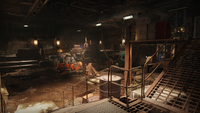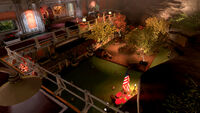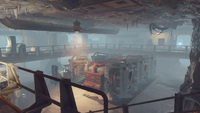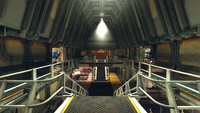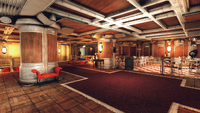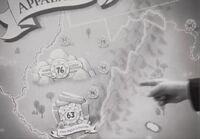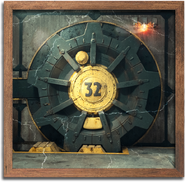| For a list of Vaults, see List of known Vaults. |
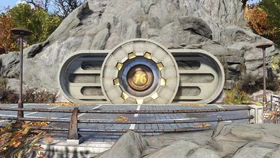
The entrance to Vault 76 in Appalachia.
Part of a series on |
| Vault-Tec Corporation |
|---|
| Subsidiaries |
| Future-Tec · Hawthorne Medical Laboratories · Vault-Tec Game Studios |
| Notable facilities |
| Vaults (List of known Vaults) · Vault-Tec headquarters · Vault-Tec Regional HQ · Vault-Tec University · Vault-Tec: Among the Stars |
| Notable technologies |
| Vaults · CAMP · Food paste · G.E.C.K. · Series 1000 shelter · TOMIS · VATS · Vault Star super-reactor · ZAX |
| Miscellaneous |
| Multi-generational starship · Project Safehouse · Vault Dweller's Survival Guide · Vault-Tec bobblehead |
The Vault™ series of survival shelters is a type of hardened subterranean installation designed by Vault-Tec Corporation on contract with the U.S. government to supposedly protect a selected fragment of the United States population from nuclear holocaust so that America could be repopulated.[1] However, outside a minority of control Vaults, the main purpose of the Vaults were to experiment on the American population in order to conduct scientific research.
Although the term vault has many meanings, including a bank vault, it was trademarked by Vault-Tec to refer to their particular brand of shelter and thus capitalized.[2]
Vaults are not to be confused with the Series 1000 shelter or the shelters seen in Fallout 76 which are similar in function, but different in goal: Short vs. long term survival.
Background[]
Project Safehouse[]

A Vault-Tec advertisement for Vault 13.
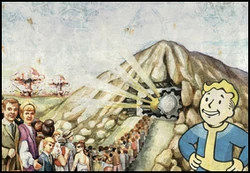
A Vault-Tec poster
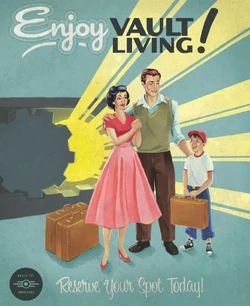
A Vault-Tec propaganda poster which hides the reality that many Vaults were sites of civil unrest and mental/physical torture
The origins of the Vault network date back to the early 2050s, when the Euro-Middle Eastern War, the New Plague, and the collapse of the United Nations resulted in a nation-wide scare. In response, the government set Project Safehouse in motion in 2054. This massive national defense endeavor was intended to create shelters that would protect the population in the event of a nuclear war or plague. Breakthroughs in construction techniques allow for these gargantuan bunkers to be constructed at a rapid pace.[Non-game 1][Non-game 2]
The impoverished government was forced to finance the project with junk bonds and even then, only 122 Vaults were ever commissioned, allowing less than 0.1% of the population to save their life in the event of the holocaust. The sheer costs of a single Vault are staggering. For example, the intended budget for Vault 13 was $400 billion dollars, and by the end of its construction the total costs reached $645 billion, well over 150% of the initial figure.[Non-game 3]
As a crucial element of national defense, much of the project was classified and protected under the New Amended Espionage Act, encouraging embezzlement and corruption.[Non-game 4] Installations built as part of the Vault-Tec Societal Preservation Program commonly claimed to have a chance to fail equal to 1,763,497 to 1; however, the reality was a far cry from this bold claim.[3]
Following the success of Vault-Tec Corporation's demonstration Vault built near their headquarters in Los Angeles at the time,[Non-game 5] the company won the bid for constructing the shelters. The building of the shelters proceeded rapidly and most were completed by 2063. The construction of several Vaults was delayed, particularly Vault 13 (which only started construction in August 2063) and the network surrounding Washington, D.C.[Non-game 6] Some were delayed due to work stoppage.[4] Ongoing drills in completed shelters slowly created a "cry wolf" effect. Turnouts for the drills fell as the years went on, further limiting the Vaults' role in ensuring the survival of humanity.[Non-game 7]
Additional problems were caused by consistent mismanagement, corruption, and embezzlement that seemed to define Project Safehouse before the war. Yet for all these problems, Vault-Tec was able to create a number of miracle technologies and develop shelters that really protected the inhabitants, as long as they worked properly.[Non-game 8] Vault-Tec even advertised Vaults in newly annexed Canada, though these were in the early stages of completion.[5] It was also a tremendous success for the company, allowing it to expand its headquarters to Washington, D.C.[Non-game 9] and even sponsor a large exposition at the Museum of Technology in the capital, designed to promote their shelters and explain their functionality.[6] Promotional tours and awarding of prizes like the Pressed Vault Suit Award were also used to promote a positive image of the company, regardless of the numerous problems associated with it.[7]
| Vault construction timetable | ||
|---|---|---|
| Number | Construction begins | Construction ends |
| Vault 13 | August 2063 | March 2069 |
| Vault 76 | 2065 | 2069 (planned) 2076 (actual) |
| Vault 87 | May 2066 | May 2071 |
| Vault 92 | May 2062 | May 2068 |
| Vault 106 | May 2064 | December 2069 |
| Vault 108 | March 2061 | December 2069 |
| Vault 112 | November 2068 | June 2074 |
True purpose[]
Contrary to what its demonstration Vaults would claim, the Vaults were not meant to save humanity in general. The entire program was hijacked by a national conspiracy involving human experimentation overseen by what would become the Enclave.[Non-game 10] Project Safehouse was subverted for its own ends. Rather than act to save humanity directly, Vaults were built to test their population as part of the Societal Preservation Program.[8] The Program was basically a vast data gathering exercise, to provide the Enclave with the information necessary to construct a multi-generational starship that would take a select group of people ("the best and brightest") off world to colonize new worlds, rather than try to restore the Earth: Enclave projections assumed the worst possible outcome: Global thermonuclear war renders Earth completely uninhabitable.[Non-game 11] Outside of the Enclave, this information was privy to only select Vault-Tec personnel (mostly overseers) and high ranking members of the military-industrial complex, such as the leadership of Big MT.[9]
As such, all Vaults were designed to feed data to the Enclave. Of the 122 known public Vaults, 17 were designed to work more or less properly, as control Vaults.[10] The 105 other Vaults were presented with a variety of scenarios, ranging from annoying to downright lethal, to gauge how humans would react and how they would survive them (if at all):[Non-game 12] Some were not provided with enough food synthesizers for their population, others had only men in them, or were designed to open prematurely. Each of these unique circumstances would provide vital data for the spaceship construction,[11] helping the Enclave to figure out how to sustain people for hundreds of years in cryonic suspension and generations of the crew necessary to maintain the ship, how to create sustainable, closed ecosystems to grow food, purify water, and maintain breathable air, and in the case of control Vaults like Vault 8, to test how recolonization of the surface using a Vault as base could work. Even Vault 13, ostensibly a control group, was intended to find out the theoretical lifespan limitations of Vault-Tec technologies.[Non-game 11]
Vault-Tec itself didn't simply act as intermediary: It used the shelters to create technologies that could be used to redefine society even if the starship project fell through. An entire Vault was set aside to act as proving grounds intended to test a variety of prototype devices with the aim of rolling them out through the rest of the Vaults. Once Vault 88 was fully operational, the company expected to roll out new devices every fiscal quarter. Unlike other Vaults, Vault-Tec would send test subjects before any disaster scenario, starting in early 2078. Human lives were considered irrelevant, with quick iteration time given a priority.[12] The prototypes were meant to convert "useless" exercise into a socially-useful activity, manipulate the moods of the dwellers, or even develop crude forms of mind control.[13] Ethical concerns were dismissed as counter-productive and close-minded.[14]
The Great War[]
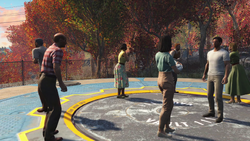
Residents of Sanctuary Hills, Massachusetts after rushing to Vault 111
On October 23, 2077, the Great War came. The Vault-Tec air raid sirens blared, but the "cry wolf" effect resulted in few people going into the shelters. They were sealed and the experiments entered their decisive phase. The control Vaults functioned as intended and protected their populations. Others were not so lucky.[Non-game 13][15]
Within the next few decades, many shelters would fail as a result of their experiments. The few that did survive would often prosper. In 2091, after receiving the all-clear signal, Vault 8 opened and Vault City was founded.[Non-game 14] A year later, the demonstration Vault in the ruins of Los Angeles opened. The inhabitants founded Adytum in what became known as the Boneyard.[Non-game 15] Years later, Vault 15 opened.[Non-game 16][16] While a large portion of the Vault inhabitants that left the overcrowded Vault would band into raider tribes by the winter of 2097[Non-game 17] (marking the beginning of the Khans, Vipers, and Jackals),[Non-game 18] the remaining Vault dwellers would found Shady Sands in spring. The town used its G.E.C.K. well.[17] No one expected that these humble beginning would eventually culminate in the formation of the mighty New California Republic.[Non-game 19]
There was a darker side to the Vaults. As protective as they were, they would also ensure that the population within would be kept put for whatever purpose someone with less-than-ethical intentions might have for them. Such was the case in 2155, when the Master's forces captured a caravan of Vault dwellers from the L.A. Vault. He learned the location of the Vault and moved his base of operations there. Learning of other Vaults in the area, he realized their occupants were perfect subjects for his project. The super mutants began to scour the region for the Vaults, boosting the output of the Mariposa vats tremendously.[Non-game 20][Non-game 21]
Eighty years later, Vaults would serve another nefarious purpose, as the Enclave, the architects of the original experimentation program, raided Vault 13 on March 16, 2242; the inhabitants were taken to the oil rig, so that the inoculation rendering humans immune to the FEV-based toxin could be tested.[Non-game 22][18]
By the late 23rd century, very few functional Vault-series shelters remain. The only known Vaults that still maintain societies comprised of the original dwellers and/or their descendants are Vault 101 (circa 2277), Vault 81 and Vault 118 (2287), and Vault 4 and Vault 33 (2296). Some other Vaults have kept their original experimental functions ongoing, such as Vault 112 (2277) and Vault 31 (2296), while many Vaults have been repurposed by outside factions as strongholds or, in the case of Vault 21, a hotel.
Construction[]
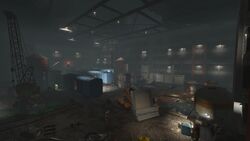
Vault 88's primary construction site, demonstrating typical late model construction efforts: Railway deliveries, heavy equipment, prefabricated elements, and large caverns shored up to withstand intense construction.
A typical Vault is built deep underground in a geologically stable area (typical choices include mountain ranges[19] and remote areas away from population centers),[20] but such shelters have also been built below the foundations of modern cities[21] in order to survive the effects of a nuclear blast.[22] Vault-Tec's method was patented as the Triple-S Technology (Safety, Survivability and Sanitation),[23] to provide a maximum of comfort to the inhabitants without compromising their safety. Vaults were typically built using reinforced concrete and solid metal sheeting to ensure durability and longevity of the shelter construction.[24] The primary protection came in the sheer amount of earth covering: Vault 13 was shielded by 3,200,000 tons of soil, at 200 feet (60m) of thickness,[Non-game 23] while Vault 88 was sheltered by granite deposits common to Quincy.[25]
The entrance was controlled by a Vault blast door and an airlock.[26] The Vault doors had a projected 2% failure rate in case of a direct hit by a nuclear missile.[27] The only shelter hit by a nuclear weapon is Vault 87 and the blast damaged the door beyond repair.[28] Some featured additional protective measures, such as an additional external blast door and reinforced access corridor, like Vault 8, or were accessed vertically through an elevator inside a protective dome that caused to blast wave to sweep over the dome and leave the Vault door intact, as is the case with Vault 111. Regardless of the presence of these measures, all entry points into a shelter were overpressurized to keep contaminants out.[29]
The precise method of constructing Vaults evolved greatly as Vault-Tec accumulated experience in constructing these vast underground shelters. The first shelters were built using contemporary technologies, combining prefabricated elements with poured concrete and modular machines and electronics.[30] The demonstration Vault built in Los Angeles set the standard for this first generation of Vaults built in California, which used the same kind of technology used for military and industrial construction, such as nuclear reactors, military bunkers, or corporate research facilities.[31] Vault-Tec quickly started implementing its own, purpose-built technologies. Vaults started becoming more and more modular, using entire prefabricated sections built to spec on the factory floor and assembled on site. Many second-generation shelters exhibited a combination of both old and new technologies, with the only fully next-generation Vaults built on the East Coast, in Boston and Appalachia.[32] These were built entirely using prefabricated sections complete with all the necessary infrastructure, fixtures, and fittings, greatly reducing construction times.[33]
By 2077, Vault-Tec could rapidly construct Vaults, especially in areas where natural or artificial features such as stable cave networks or underground tunnels permitted it. For example, the stability of Quincy's granite quarries and the ground allowed extensive excavation operations, creating a network of natural and artificial caves. After reinforcement, these caves were connected to a temporary railroad that rapidly delivered all the necessary prefabricates, construction equipment, and other necessities.[34]
Infrastructure[]
In order to power the entire installation, Vaults were provided with a variety of power sources, depending on local geology and the actual size of the Vault (with the average being approximately 220 dwellers).[35] The largest of them, like Vault 13, required nearly 3.98 MWh/day for continued operations for its 1000 occupants (housed in a hot-bunking system). In order to meet the demand, the shelter used a geothermal power plant as a primary source, with General Atomics nuclear power as backup.[Non-game 23] Infrastructure is designed for durability, but also for convenience. Critical elements are usually hidden behind wall panels so as to keep them out of harm's way.
The usual go-to solution was geothermal power, in areas where it was practical. If not, the usual fallback option was the aforementioned General Atomics nuclear power plant, often used as the primary power source due to its reliability and scalability. Concrete, steel reinforcements, and SimuSun lighting were also utilized. Vaults can hold double the number of occupants under a hot bunking system. Vaults are known to use the systems listed below.
| Vault | Number of occupants | Primary power supply | Secondary power supply |
|---|---|---|---|
| Vault 8 | Unknown, estimated at 100-200[36] | Nuclear reactor[37] | None |
| Vault 13[Non-game 23] | 500 (1000 with hot bunking) | Geothermal | General Atomics nuclear power |
| Vault 51[38] | 52 (at sealing) | Vault Star super-reactor | None |
| Vault 75[39] | 88 | Unknown | Unknown |
| Vault 76[10] | 500, later reduced to 88[40] | LightLife geothermal[10] Dual Vault Star super reactors[41] |
General Atomics nuclear power |
| Vault 81[42] | 96 (plus unknown number of researchers) | Nuclear reactor | None |
| Vault 87[43] | Unknown | General Atomics nuclear power | Versicorps fusion power |
| Vault 88 | Construction unfinished, none given | Vault-Tec super reactor | None |
| Vault 92[44] | 245 | General Atomics nuclear power | None |
| Vault 94[45] | Unknown | Class-VI fusion reactor | Class-VIb fusion reactor
Two Class-VIII reactors servicing G.E.C.K. containment and control |
| Vault 95[46] | 72 | Unknown | Unknown |
| Vault 106[47] | 107 | Rok-Solid Brand geothermal | General Atomics nuclear power |
| Vault 108[4] | 475 | General Atomics nuclear power (designed to fail after 240 months or 20 years) | Steam Whistle mini geothermal |
| Vault 112[48] | 85 | Sure Power geothermal | X-Tra Sure Power geothermal |
| Vault 114[49] | 120 | Unknown | Unknown |
All of that power was necessary to power the facilities necessary to sustain the people living within. Apart from air filtration systems required to keep the air breathable, which was already an issue without toxic contaminants leaking in,[50] Vaults also included hydro-agricultural farms and food synthesizers to provide sustenance,[51] water purification systems (able to take even sewer waste and convert it into up to 15,000 gallons of drinkable water each day with no loss of output for 250,000 hours of operation),[52] and other necessary amenities, like a Vault-wide intranet allowing instant access to any entertainment, social, and educational files from any terminal in the Vault.[53] Vaults were also equipped with incinerators for disposal of the dead and likely other waste products.[54] Security was provided by heavy duty doors (which could be sealed by security in case of disturbances) and an extensive network of Eye-On-You surveillance cameras.[55] The entire Vault was typically managed by a single, centralized computer system, the most advanced of which is the ZAX series of supercomputers, currently known to have only been used in Vault 51.[56] The most common brands were Brainpower and Think Machine.[57][Non-game 23]
All of the systems were reported to function without failure for nearly 900 years,[58] though the uneven quality of components would prove this claim untrue. For example, the water chips were manufactured by a low-bid contractor, resulting in poor quality and a high failure rate. Such was the case with Vault 13 in 2161, exacerbated by the fact that the process was too complicated for a workaround system.[59] For the resettlement of the surface, the shelters were provided with complete construction equipment[Non-game 23] and preselected installations received one or two G.E.C.K.s, intended to help the inhabitants create a viable civilization in the post-nuclear world after the "all clear" signal is sent.[60][61]
Vault dwellers[]
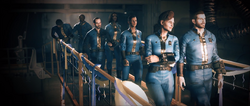
A group of Vault dwellers wearing their blue-and-yellow jumpsuits
The total number of inhabitants could be as high as 500 (1,000 with hot bunking)[62] in installations like Vault 13[Non-game 23] and Vault 76[10] and as low as 100.[47] As the government only commissioned 122 Vaults as part of Project Safehouse, only a fraction of the 400 million U.S. citizens would actually be accepted into the Vaults.[Non-game 24] The duration of stay varied. Some shelters were only intended to stay sealed for ten years (Vault 13, though this directive was overridden), while others were designed for 38 years and more, like Vault 108.[4]
Since the Enclave never really intended for the Vaults to save anyone, they used Project Safehouse and Vault-Tec's network of shelters for a grand social experiment, to test the occupants in unique circumstances.[51] The Enclave eventually abandoned their goal of settling on another planet and decided to resettle the one they already had. Vault monitoring and research continued as the Vault Behavioral Project. In order to monitor the populations being experimented upon, the Enclave's oil rig possessed a great deal of equipment that allowed them to observe and control the Vaults. For example, the Enclave sent the all clear signal to Vault 8 shortly after the war, prompting them to leave the shelter and build their city. These monitoring tools also let the Enclave see that the population of Vault 13 was largely intact, although this wouldn't become important until much later.[Non-game 25][63]
Pre-selected segments of the population accepted into Vault-Tec's shelters would enjoy a very high quality of life, though it would be completely different from the free market capitalist consumerism experienced on the surface - a planned socialist utopia underground (giving China the last laugh). As a closed system, the Vaults were designed to recycle and reuse[64][65] as much as possible and implement a completely planned economy that would maintain the system for the planned duration of the Vault. Every inhabitant would be registered with a unique 11 digit Vault identification number (or VID)[Non-game 26] and provided with clothing, bedding, and other accommodations necessary for their life within the Vault.[66]
The only exception was food and water, as these could only be procured with the proper ration coupons (at least in some Vaults).[67] Luxury, non-essential goods were available for purchase in exchange for work credits, a form of currency earned through performing work for the Vault. The aforementioned ration coupons would sometimes also be used as a form of currency.[68] Nourishment would be provided by a combination of food grown in hydroponic farms, like in Vault 13, or food synthesizers, capable of creating a variety of foodstuffs. Water would be provided by purifying liquid drawn from the local water table.[Non-game 23]
Vault dwellers would be unable to use their own clothing in the long term. While dwellers could arrange to have their belongings sent to their quarters in advance, there was a strict policy disallowing bringing baggage along in case of an emergency entrance.[66] The uniform Vault jumpsuit would replace regular clothes. Manufactured inside the Vault, it was designed for utility and comfort. Enterprising dwellers could, however, customize theirs to add a bit of individuality to the generally conformist design.[69] Planning and conformity also extended to other areas. For example, trash disposal would only be permitted in designated receptacles on pre-set trash burning days. These receptacles would also be used for the disposal of corpses, as there was no space for proper burial in the confined environment of the Vault.[70] Children would also be assigned their first work duties starting with the day after their tenth birthday.[71]
In exchange for these sacrifices in lifestyle, dwellers would receive private quarters provided with the latest in home appliances, including Floorsuck Autocleaner Systems to minimize sweeping,[72] Culinator 3000 Kitchen Systems for cooking,[73] and access to complete libraries of social and entertainment files[Non-game 23] together with the public Entertainotron room.[74] A standardized education would be received by all Vault dwellers, including schooling in arithmetic, chemistry, biology, history, and other sciences.[75] Tertiary education would also be provided and Vault-trained specialists would be highly sought after the apocalypse and count on a stable career in their chosen field, like Doc Mitchell from Vault 21, who opened a practice in Goodsprings after the Vault was opened.[76]
Their health would be assured by well-educated doctors with access to the latest in medical technologies. Auto-Docs capable of performing a broad variety of procedures and manufacturing medical drugs[77] were the standard issue of the Emergency Medical Labs (which were equipped well enough to rival clinics).[78] Some Vaults were also equipped with facilities for cloning replacement tissue and organs.[79] To avoid the development of medical problems, shelters were lit using a Simu-Sun lighting system simulating natural sunlight.[80] It was estimated that living in a properly maintained Vault would result in an average lifespan of 92.3 years.[81] Prolonged isolation, even in generations born after entry, took its toll. Vault depressive syndrome was a common problem, manifesting as intense depression that could be debilitating. The usual recourse was to prescribe and treat it with anti-anxiety medication.[82] Furthermore, those who exited successful Vaults seem to have a heightened chance of suffering from xenophobia (fear of strangers) and/or agoraphobia (fear of open places).[83]
Security inside the Vault was provided by its dedicated security force, usually hand-picked by the overseer. A typical Vault was provided with enough firearms and armor to arm ten men.[Non-game 23] Surface monitors and communications systems were designed to facilitate connecting with other Vaults,[Non-game 23] though this functionality was either never implemented or failed soon afterwards.[Non-game 27][Non-game 28]
Layout[]
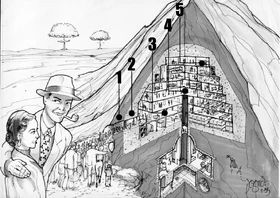
Due to the nature of the project, Vaults were provided with standardized facilities and layouts. Some Vaults were built according to a uniform design plan (like Vaults 8, 12, 13, and 15), while others had to be adapted to local geological features. The following section attempts to summarize the most common design features.
Common schematic of Vault design used in mountainous areas.
1 - Natural bedrock
2 - Reinforced concrete that creates the outer shell of a Vault
3 - Entrance area
4 - Living quarters
5 - Command center
Entrance[]
A Vault was designed to provide the best possible protection from nuclear fallout, indirect blast effects, and any unrest that might occur following a global thermonuclear war. Protected by a massive Vault blast door available in several different variants, from the basic Seal-N-Safe Model No. 343,[84] through fortified doors, all the way to the high tech fortified Vault entrances, the entrance area would double as an overpressurized airlock. There future dwellers would undergo decontamination and processing by Vault-Tec personnel, then change into Vault jumpsuits provided in sealed packages before entering the Vault.[85] Vault doors would be operated either remotely[86] or from control pods located near the door (both outside and inside the Vault). Specific access codes would be necessary to operate the door.[87] Some Vaults were provided with an external blast door, providing additional protection against the blast.[88]
Several layouts were developed for entrance areas. The earliest designs, derived from the demonstration Vault,[89] had a simple airlock, terminating in a security door fitted with additional armored plating to deter attackers and protect against radiation. This airlock would typically contain a status terminal and a locker for emergency supplies.[90]
Later, more advanced layouts greatly expanded the airlock into a fully-featured processing and decontamination station. Advanced Vault doors and airlocks would funnel prospective Vault dwellers into a decontamination shower and then to a separate area for disrobing and changing into jumpsuits (which would later double as a staging area for excursions), before allowing them to enter the shelter. A separate room to the side would be used for monitoring purposes.[91]
The latest, fortified airlocks seen only in high-tech areas such as the Commonwealth further iterate on the system. The entry door connects to a retractable catwalk leading into the Vault, monitored by security officers and staff during processing. The entrance area, painted in warm colors with a reassuring corporate slogan prominently displayed (Welcome Home), would typically include a security station and an array of radiation scanners that would analyze people entering the Vault proper.[92]
- East and West Coast (nine-cog model)
- Massachusetts and West Virginia (fortified model)
Living quarters[]
Living quarters were typically located deeper into the Vault and their design varied by the installation. A standard level had 20,000 square feet of usable area.[Non-game 3][93] The standard approach was to provide discrete apartments to Vault couples, provided with a private sanitary compartment, terminal, and a bed, on top of any additional amenities they may require.[94]
Different philosophies were implemented depending on the designer and the intended purpose. Some did away with apartments in favor of separate dormitories for genders,[95] where multiple dwellers would occupy the same room, or for apartment blocks composed of a bedroom (with one or two beds, the former typically utilized under hot bunking) and living space, with common lavatories accessible in the corridors.[96] Other facilities typically located in living quarters include diners, cafeterias, classrooms, laundry rooms, and even cigar lounges.[96]
Emergency medical lab[]
Typically found on the entrance level, the EML is one of the most important places in the shelter. Despite its name, a typical EML is a fully-featured medical clinic allowing dwellers to undergo medical procedures in a safe and sterile environment. A medic is expected to be present on site 24 hours a day, to respond to any emergencies immediately.[97] The EML typically varies in size between Vaults. Some installations abandon the moniker entirely and simply refer to it as the clinic.
Command center[]
The command center is the nexus of Vault activity, where all the computers necessary to maintain the Vault's various functions. Centered around the overseer's office, it typically incorporates the security station, armory, computer core, meeting room, and library, although many variations of the layout have been developed.[98]
The oldest Vault designs usually dedicated an entire floor of the Vault for these purposes, owing to the multiple functions it was supposed to fulfill. One wing of the level would incorporate the overseer's office, a vaulted chamber with a command post equipped with a pair of CZ-53 5mm miniguns designed to defend the overseer, connected to the main processing computers (including the water purification controls)[99] and the security post with the Vault's main armory. A Vault security guard would be posted in the area on watch around the clock.[100]
Later designs would forgo the inclusion of a discrete command post and hall, in favor of a more modest office. The workplace of the overseer would typically be located in an area overlooking the atrium - the center of activity within the Vault, where dwellers would spend their leisure time, socialize, and even engage in sports.[101] The office would typically connect to necessary administrative and security facilities, such as the computer core, security station and armory, laboratories and the personal quarters of the overseer and their family.[102]
Notes[]

A map of the Vaults
- In the TV series, a map of the intended Vaults is shown with only 115 dots, although it is possible some dots are hidden behind the presenters. If one overlays a map over it, it seems all states have Vaults except New Hampshire and Indiana. It also suggests there is a Vault in Canada, either in Saskatchewan or Manitoba, as well as at least one in Mexico.
- Vault 51 was outfitted with a ZAX AI, which sought out an overseer.
- Vault 12 had its overseer's room sealed due to the fact that the main door of the Vault was doomed never to close.
- East Coast Vaults and Mojave Vaults (3, 11, 19, 21, 22, 34, 51, 63, 75, 76, 81, 87, 88, 92, 94, 95, 96, 101, 106, 108, 111, 112, 114, 118) use a different door mechanism than on the West Coast/California. These Vaults employ an opening mechanism that is contained entirely within the Vault itself, pulling the door inwards and simply rolling it to one side. The doors seen on West Coast/California Vaults, however, pull the seal outwards and use an external clamp to slide it aside (with the exception of Vaults 4 and 33, which use a similar design to that of 76).
- East Coast and Mojave Vaults lack storage rooms in the overseer's office; they are instead located near the atrium.
- Vault 0 (Fallout Tactics) and the Corporate Vault (Fallout Brotherhood of Steel) had an entirely different layout than other Vaults.
- Vault 76 has a unique Vault door exterior design, having a prominent plaza with Vault 76 signage around it, rather than the concealed entrances seen on most other Vaults. Vault 33 also uses this door design, but with minor alterations.
- Vault 81 has an entire wing that is cut off from the rest of the Vault.
- Vault 111 and Vault 118 both have an elevator exit leading to the surface just outside the airlock.
- Vault 114 can be found inside Park Street station.
- Vault 118 has a parking garage and is under Cliff's Edge Hotel.
- The Commonwealth, Appalachia, and Maine Vaults are painted in a yellow and blue shade, while Washington D.C., California and Mojave Vaults are a dull metallic gray. Also, the Commonwealth, Appalachia, and Maine Vaults' hue is the same as the traditional Vault jumpsuit, compared to the lighter blue seen in D.C. and the Mojave.
- Thus far, all known Vaults with a number lower than Vault 34 have been on the western half of the U.S., while all known Vaults numbered 51 and over have been located on the east half.
Appearances[]
Vaults appear in all Fallout games to date.
Behind the scenes[]
The Vaults encountered over the course of the many games imply that there's somewhere below 200 Vaults, although it's also possible that the number is even lower and that some Vaults were just never completed (leaving gaps in the numeric list). California has a big population so it presumably might have a large number of Vaults-but it also might not; since forces behind the scenes turned the Vaults into labs for sociological experiments, their purpose was not to save large quantities of people, but to draw people from a local town into an unwitting experiment. You don't need to place a huge number of Vaults in the places with lots of people if your true goal isn't saving as many people as possible.
Once the bombs drop, communication infrastructure collapses. There are any number of reasons that the Master might not have any record of a Vault right under their noses, since there is no guarantee that the Master has access to an actual and complete listing of every Vault, the Master's "help" isn't always the most competent, and some Vaults may take more rigorous steps than others to protect themselves from the outside world.”— Jesse Heinig, Modiphius Discord- As per original Fallout developer Jesse Heinig above, the original development team never had a definitive list of Vaults created or a hard number while Fallout was worked on. Heinig suggests that there are under 200 Vaults based on the numbers of Vaults seen in the Fallout series thus far, with gaps in numbering due to a lack of completion and/or straight-up corruption.
- The visual identity of the Vaults from Fallout 3 onwards was defined by the late Adam Adamowicz. His work would continue to influence developers, as their look in Fallout 4 was inspired by his concept art and many details not featured earlier made their way into the next generation game, for example, the angled lamp in living quarters modeled by Josh Jay.
- A trailer for Fallout 76 states Vault 76 was the first to be opened after the Great War. This is not actually true, even in the context of Fallout 76:
- Vault 94 — reopened on October 23, 2078, and eventually led to the creation of The Mire.
- Vault 87 — the Fallout 3 guide mentions, "The dwellers of Vault 87 were turned into Super Mutants in 2078, and have been a presence in the Capital Wasteland ever since" which suggests they did manage to leave the Vault.
- Vault 29 — Harold is said to have left in 2090 according to the Fallout Bible
- Vault 8 — was opened in 2091 according to Fallout Bible
- Los Angeles Vault - was opened in 2092 according to Fallout Bible
- Vault 15 — was opened in 2097 according to Fallout Bible
- Vault 22 — Sylvie is said to be out of Vault 22 by 2097 according to Year: 2097
Experiment[]
- The Vault experiment was an idea created by Tim Cain and Leonard Boyarsky during the initial stages of Fallout 2 development. While the introduction of this idea was established in the Bible in 2002,[Non-game 29][Non-game 30] it took a further 21 (!) years for Tim Cain to reveal The True Purpose of Vaults in Fallout. Coined at the end of the development cycle of Fallout, Cain was inspired by a conversation with Chris Taylor, who pointed out that even with a thousand Vaults the size of Vault 13, Vault-Tec could only preserve a million US citizens at most, out of a population of hundreds of millions. Cain agreed, and reflecting upon the 1950s projections for human survival in the wake of a global thermonuclear war - which consistently foresaw an uninhabitable, irradiated hellscape - realized that this could be the point of the Vaults: The Enclave assumed that the Earth would be uninhabitable and decided to build a multi-generational starship to colonize another planet and begin again. However, lacking the know-how on how to build such a vessel (apart from mastering nuclear fission to power it for centuries), it would need data. From there, it was a simple step to have the Vault-Tec director suggest using Vaults as giant social experiments to gather data on building the vessel, testing technologies, and addressing contingencies. Vaults in Fallout 2 were (re)designed with that purpose in mind, and retroactive continuity made it easier to explain the Vault Dweller's banishment in Fallout. Cain noted that while he isn't aware of the design specifics in subsequent games, he always interprets them through the "starship lens" and sees how the even strangest experiments could provide data useful to making a generation ship.[Non-game 11]
- The developers actually intended for the player to first encounter information about the Vault experiment as they read the Vault 8 records in Fallout 2. They could discover a classified file (opened with a successful Science skill roll) explaining the purpose of Vault 8 was to be a "control Vault," designed to hold 1000 people and open at a designated time. This file was intended to foreshadow the discovery of the true and sinister purpose of the Vaults. The player character could also apply their Science skill to the central computer in Vault 13 to obtain a history of Vault 13, the overseer's involvement in the Vault Dweller's expulsion, and even worse, the true purposes of the Vaults. The overseer was conscious of the true purpose of the Vaults as social experiments on a grand scale, and consequently drove out the Vault Dweller because of fear they would ruin the experiment or uncover it.[Non-game 31]
- Vault 29 and Vault 70 were to appear in Van Buren, the canceled Fallout 3 project by Black Isle Studios. Van Buren was also the first game to directly elaborate on the starship idea via the location of Bloomfield Space Center, but the idea never manifested and wasn't explored in depth in design documents.
- A Vault 69 advertisement appears in Van Buren concept art.
Vaults from media[]
| For Vaults not seen in the game, see List of known Vaults. |
Fallout[]
Fallout 2[]
Fallout: Tactics[]
Fallout: Brotherhood of Steel[]
Fallout 3[]
| Concept art |
|---|
Fallout: New Vegas[]
Fallout 4[]
| Textures |
|---|
Fallout 76[]
| Maps |
|---|
Fallout TV series[]
Videos[]
See also[]
References[]
|
Non-game
- ↑ Fallout Bible 0: "2054 In light of the Euro-Middle-Eastern conflict and the plague scare, the United States sets Project Safehouse in motion. The project, financed by junk bonds, is designed to create shelters, called Vaults, for the populace in the event of a nuclear war or deadly plague. Construction begins late in 2054 and proceeds rapidly due to advances in construction technology."
- ↑ Fallout history marketing picture
- ↑ 3.0 3.1 Fallout manual
- ↑ Vault Dweller's Survival Guide title page: "NOTICE.––This document contains information affecting the national defense of the United States within the meaning of the New Amended Espionage Act, 50 U.S.C., 31 and 32. Its transmission or the revelation of its contents in any manner to an unauthorized person is prohibited by the law."
- ↑ Chris Taylor interview for Vault13.net:
Saint Proverbius (SP): "Which Vault number was the Master's base?"
Chris Taylor (CT): "The Master was in the Vault-Tec private Vault. This was the demonstration model built for the federal government, it was also very close to the Vault-Tec headquarters." - ↑ Fallout Bible 0: "2063 August The construction of most Vaults completed, except for Vault 13, whose construction finally gets off the ground... heralding a development cycle that seems plagued with problems. Drills begin in the other cities with completed Vaults, but the increasing frequency of the drills has a "cry wolf" effect, and the turnouts for drills trickle off as the years go on."
- ↑ Fallout Bible 0: "2063 August The construction of most Vaults completed, except for Vault 13, whose construction finally gets off the ground... heralding a development cycle that seems plagued with problems. Drills begin in the other cities with completed Vaults, but the increasing frequency of the drills has a "cry wolf" effect, and the turnouts for drills trickle off as the years go on."
- ↑ Fallout Bible 6:
"1b. What may be suitable for planting in the present may not be suitable in 20 yrs. This is esp true I would think in the FO universe with its rather unstable ecosystem. I mean if one really wanted to be certain that what one was panting would grow the best thing to do would be to collect the seeds, spores etc from already growing food sources - these have a guaranteed fertilization rate. After all those corn seeds that were put in the GECK 50 yrs ago now have not sufficiently mutated to endure the new Wasteland (even in a "normal" ecosystem, the only strains of plant that survive are those that mutate)."
"You're absolutely right. The GECK builders had no idea what the post-nuclear world would be like, and they had no real way to anticipate it, despite their "thorough tests" (it's doubtful they gave it much thought, to be honest, considering how badly organized the Safehouse project alone was, not to mention the experimental nature of the Vaults) - still, it seems as if the seeds present in the GECK were viable for Vault 8." - ↑ Chris Taylor interview for Vault13.net:
Saint Proverbius (SP): "Which Vault number was the Master's base?"
Chris Taylor (CT): "The Master was in the Vault-Tec private Vault. This was the demonstration model built for the federal government, it was also very close to the Vault-Tec headquarters." - ↑ One Man, and a Crate of Puppets, panel 1: "The Vault
Experiments were never designed to rescue the people that lived inside them. They were a vast social experiment designed to study pre-selected segments of the population." - ↑ 11.0 11.1 11.2 Cain on Games, The True Purpose of Vaults in Fallout
- ↑ Fallout Bible 0:
"I read the start thing of the bible thats on the net. One thing I don't agree with in the fallout universe is that the Vaults were just a bunch of "social experiments". I mean why. Even though the enclave were a bunch of assholes, why would they want to purposely see their own country men die when the Vaults were societies last chance at a good survival. I like to think that lots of people died because the Vaults just didn't work. Like in FOT there is a terminal that says that money had been diverted from much needed common sense things to an underground game hunting facility or whatever it was. experiments was a bit over the top, but corruption is far more believable. that's what i think anyhow. and Fallout 3, is it a possibility or not?"
"Michael"
"Answer: The Vault experiments were an idea created by Tim Cain, and I don't really know the reason behind them, but I can offer some speculation."
"First off, thematically, it's pretty creepy, and we all know that developers will pull all sorts of crazy shit to try and mess with players' heads. It's possible that Tim had just finished watching an X-Files episode and had conspiracy theories swimming around in his subconscious. As to your comment about the experiments being a bit over the top, well, yeah. We're guilty as charged."
"Secondly, as proven time and again in Fallout 2, the Enclave isn't a particularly rational bunch of fellows. Thematically, they embrace a paranoid view of the world and a heightened sense of superiority over everyone else in Fallout."
"Third, the federal government (or whatever branch of federal government was responsible - it was not necessarily the Enclave) may not have ever considered the Vaults as society's best chance for survival - the government may have considered themselves the best candidates for rebuilding the world and already had their asses covered in the event of a nuclear or biological war by relocating to other remote installations across the nation (and elsewhere) that weren't necessarily Vaults. The Enclave certainly didn't seem to be devoting much effort to digging up any other Vaults and trying to use the human stock there to rebuild civilization."
"Fourth, a lot of people did die because the Vaults didn't work. Some suffered worse fates."
"Nonetheless, even members of the Enclave probably could not answer the question of who created the Vault experiments and their reasons, as many of the people responsible for the creation of the Vaults died long ago, and many records were lost in the great static of 2077. President Richardson was familiar with the purpose of the Vaults, but he never saw them as more than little test tubes of preserved humans he could mess with." - ↑ Fallout Bible 0: "2077 October 23 Great War: Bombs are launched; who struck first is unknown... and it is not even known if the bombs came from China or America. Air raid sirens sound, but very few people go into Vaults, thinking it is a false alarm. The Vaults are sealed."
- ↑ Fallout Bible 0: "2091 Vault 8 opens, and they use their GECK to create fertile ground for their city. This eventually becomes Vault City."
- ↑ Fallout Bible 0: "2092 LA Vault opens, the Boneyard is founded and attracts survivors."
- ↑ Fallout Bible 0, Fallout Bible 3 Timeline repair: Second strike: "2141 Spring Vault 15 opened."
- ↑ Vipers design document included in the Fallout Bible establishes that Vipers left Vault 15 in 2097 (64 years before the game's time), emerging alongside the settlers that would establish Shady Sands.
- ↑ Fallout Bible 0: "2141 Winter Raiders begin to form in the region as food supplies run low. The Khans and the Vipers begin terrorizing local settlements."
- ↑ Fallout Bible 0: "2122 Spring Shady Sands founded, wall erected against the raiders."
- ↑ Fallout Bible 0: "2155-2156 After capturing a caravan of strange-garbed travelers (Vault dwellers), Master learns the location of the Boneyard Vault, the future site of the Cathedral. He conquers the inhabitants and sets up operations there, and the human cultists begin to use the Vault as their powerbase. Within the Vault, the Master learns of other Vaults, and realizing their human occupants are ripe for transformation, begins to send out patrols to Vault locations in search of these other Vaults."
- ↑ Fallout Bible 5: "2155-2156 After capturing a caravan of Vault dwellers, Master learns the location of the Boneyard Vault, the future site of the Cathedral. He conquers the inhabitants and sets up operations there, and the human cultists begin to use the Vault as their powerbase. Within the Vault, the Master begins to send out patrols to Vault locations in search of these other Vaults."
- ↑ Fallout Bible 0: "2242 May 16 Less than a day later, Vault 13 is opened, only to be greeted by two Enclave verti-assault squads. The squads kill three of the citizens who were "resisting capture," and storm the Vault, kidnapping all the inhabitants."
- ↑ 23.0 23.1 23.2 23.3 23.4 23.5 23.6 23.7 23.8 23.9 Vault Dweller's Survival Guide p.1–1: "Important Vault statistics
Vault Number ............................13
Starting construction date .........August 2063
Ending construction date ..........March 2069
Starting Budget .........................$400,000,000,000
Final Budget, with interest ........$645,000,000,000
Total number of occupants .......1,000 (at capacity)
Total duration ...........................10 years (at capacity)
Number of living quarters .........100 (hot bunking required if at maximum capacity)
Door thickness ..........................4 yards, steel
Earth coverage .........................3,200,000 tons of soil, at 200 feet
Computer control system .........Think machine
Primary power supply ...............Geo-thermal
Secondary power supply ..........General Atomics Nuclear Power backup systems
Power requirements .................3.98mkw/day
Stores .......................................Complete construction equipment, hydro-agricultural farms, water purification from underground river, defensive weaponry to equip 10 men, communication, social and entertainment files (for total duration)" - ↑ Fallout Bible 0: "Basically, the Vaults were never intended to save the population of the United States. With a population of almost 400 million by 2077, the U.S. would need nearly 400,000 Vaults the size of Vault 13, and Vault-Tec was commissioned to build only 122 such Vaults. The real reason for these Vaults was to study pre-selected segments of the population to see how they react to the stresses of isolationism and how successfully they re-colonize after the Vault opens."
- ↑ Fallout Bible 0: "Vault 13: Intended to stay closed for 200 years as a study of prolonged isolation, the broken water chip forced the Overseer to improvise and use the Vault Dweller as a pawn. Later study of the Vault 13 records by the Enclave led them to their current plan to end the war."
- ↑ Vault Dweller's Survival Guide Character biographies p.3–1-2
- ↑ Vault Dweller's Survival Guide p.5–14: "EQUIPMENT
Vault-13 comes prepared with the latest in survival equipment. The items in your storage containers will last 1,000 people over 10 years in comfortable and modern surroundings. When it is time to leave the Vault, and return to rebuild America, your friends at VaultTec have provided you with everything that you will need. We have ensured that all of your rebuilding needs will be covered"
"Yeah, right. Who wrote this? What budget did they get? We already used most of the equipment on failed attempts to contact an outside civilization. And we’ve been in here a lot longer than ten years. We have little left to give you, but we will give you what we can."
"undergone extensive testing to make sure the equipment is reliable." - ↑ Fallout Bible 4:"7. When the bombs dropped, all communication between the Vaults where severed, so if their was no way to communicate with the Vaults how did the Enclave send a massage to Vault 13 telling the people its time to go?"
"Communication between Vaults was never in place (it might ruin the experiments), but communication with the government/Enclave/Vault-Tec was a different story... they needed some way of monitoring the Vaults."
"The Enclave, having access to the Vault-Tec construction plans (not too surprising, considering the fact that the Vaults were funded by the government) had a way of monitoring events taking place within the Vaults... not only could they access their computers and systems remotely, (including PIPBoys and the personal logs of the Vault Dwellers), but the early Overseers of most of the Vaults knew of the ties to the government, and it was part of their duties to download information on the citizens and the Vault into an computer archive that the government could easily access." - ↑ Fallout Bible 0:
"I read the start thing of the bible thats on the net. One thing I don't agree with in the fallout universe is that the Vaults were just a bunch of "social experiments". I mean why. Even though the enclave were a bunch of assholes, why would they want to purposely see their own country men die when the Vaults were societies last chance at a good survival. I like to think that lots of people died because the Vaults just didn't work. Like in FOT there is a terminal that says that money had been diverted from much needed common sense things to an underground game hunting facility or whatever it was. experiments was a bit over the top, but corruption is far more believable. that's what i think anyhow. and Fallout 3, is it a possibility or not?"
"Michael"
"Answer: The Vault experiments were an idea created by Tim Cain, and I don't really know the reason behind them, but I can offer some speculation."
"First off, thematically, it's pretty creepy, and we all know that developers will pull all sorts of crazy shit to try and mess with players' heads. It's possible that Tim had just finished watching an X-Files episode and had conspiracy theories swimming around in his subconscious. As to your comment about the experiments being a bit over the top, well, yeah. We're guilty as charged."
"Secondly, as proven time and again in Fallout 2, the Enclave isn't a particularly rational bunch of fellows. Thematically, they embrace a paranoid view of the world and a heightened sense of superiority over everyone else in Fallout."
"Third, the federal government (or whatever branch of federal government was responsible - it was not necessarily the Enclave) may not have ever considered the Vaults as society's best chance for survival - the government may have considered themselves the best candidates for rebuilding the world and already had their asses covered in the event of a nuclear or biological war by relocating to other remote installations across the nation (and elsewhere) that weren't necessarily Vaults. The Enclave certainly didn't seem to be devoting much effort to digging up any other Vaults and trying to use the human stock there to rebuild civilization."
"Fourth, a lot of people did die because the Vaults didn't work. Some suffered worse fates."
"Nonetheless, even members of the Enclave probably could not answer the question of who created the Vault experiments and their reasons, as many of the people responsible for the creation of the Vaults died long ago, and many records were lost in the great static of 2077. President Richardson was familiar with the purpose of the Vaults, but he never saw them as more than little test tubes of preserved humans he could mess with." - ↑ RPG Codex interview with Leonard Boyarsky
- ↑ Fallout Bible 0: "The player was also intended to apply his Science skill to the central computer in Vault 13 to obtain a history of Vault 13, the Overseer's involvement in the Vault Dweller's expulsion, and even worse, the true purposes of the Vaults. The Overseer was conscious of the true purpose of the Vaults as social experiments on a grand scale, and he drove out the Vault Dweller because he was afraid that he would ruin the experiment... or uncover it. Of course, the Overseer himself caused problems not long after this, according to Martin Frobisher, the leader of Vault 13 in Fallout 2:
"There used to be an overseer, many years ago, but he did a bad thing and many of our people left the Vault. Only to die in the Wastes, I'm sure. He was tried and sentenced to death for his crime. We haven't used the title since."
Martin did not see the Overseer executed, however... his information comes from the Vault 13 records passed down by his ancestors."
| |||||||||||||||||||||||||||||||||||||||||||||||||||

